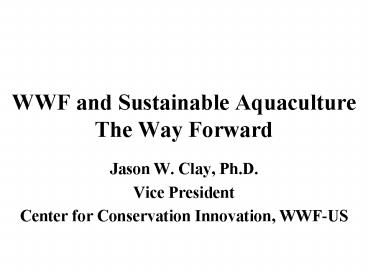WWF and Sustainable Aquaculture The Way Forward - PowerPoint PPT Presentation
1 / 12
Title:
WWF and Sustainable Aquaculture The Way Forward
Description:
Shrimp aquaculture has large impacts but more potential to improve ... Considerable conflict between NGOs and shrimp producers ... – PowerPoint PPT presentation
Number of Views:244
Avg rating:3.0/5.0
Title: WWF and Sustainable Aquaculture The Way Forward
1
WWF and Sustainable Aquaculture The Way Forward
- Jason W. Clay, Ph.D.
- Vice President
- Center for Conservation Innovation, WWF-US
2
Why WWF and Aquaculture?
- The largest environmental NGO, responsibility to
look at global trends, impacts and opportunities - Limits of traditional conservation approaches
- Interests in reducing impacts of human use of
natural resources - Concerns about the impacts of fishing
- Aquaculture is the fastest growing food
production system globally
3
WWFs Experience with Shrimp Aquaculture
- Study to compare impacts of shrimp aquaculture
vs. shrimp trawling - Shrimp aquaculture has large impacts but more
potential to improve - The industry is extremely profitable and will not
disappear, so performance needs to be improved - Considerable conflict between NGOs and shrimp
producers
4
How did WWF engage on the shrimp aquaculture
issue?
- Distributed our findings on trawling vs.
aquaculture for comment - Prepared an internal position paper on shrimp
aquaculture to guide engagement - Facilitated dialogue between industry and NGOs
- Obtained funding for research on shrimp
aquaculture impacts and ways to reduce them - Created a consortium (WWF/NACA/WB/FAO) to guide
research
5
The Shrimp Consortiums work
- Identified key stakeholders
- Hosted an initial meeting to discuss the science
relating to environmental and social impacts - Used the initial meeting to identify areas of
agreement and disagreement as well as data gaps - Developed a 3-year work plan, drafted TORs for 25
studies, and vetted researchers for studies - Made all this information available
electronically to those who could not attend the
meeting
6
What did we do?
- 3-yr, 1 MM project to identify analyze the
main impacts and BMPs to address them - 40 case studies, 140 researchers, 20 countries
- Global to specific case studies
- Presented findings at 140 meetings, reaching some
8,000 people - Synthesis translated and all cases posted on
www.enaca.org/shrimp
7
What did we find?
- 8-10 activities cause 2/3 to 3/4 of impacts
- 3-5 activities cause most impacts on a single
farm - BMPs reduce impacts to acceptable levels
- Most BMPs pay for themselves within 2-3 years
- Social BMPs are surprisingly important for
reducing impacts increasing profits - Greatest barriers to adoption of BMPs are lack of
info overall profitability without them
8
Where is the shrimp work headed?
- Present findings to new audiences
- Adapt BMPs to different producer realities
- Develop standards to measure results with regard
to key impacts - Create BMP-based screens to guide investments
- Evaluate existing certification programs against
our findings/standards - Create a meaningful certification program
9
What were the lessons learned?
- Focus on key impacts, not laundry lists
- Focus on better, not best practices
- Todays BMP is tomorrows norm
- Regulations encourage compliance, not innovation
- Need to focus on and measure results and not be
prescriptive - Innovation results from showing people how to
think rather than telling them what to think/do - Focus on cumulative and on-farm impacts
10
What other lessons did we learn?
- Reduce impacts by closing production systems, but
not overnight - Increase efficiency of input use
- Reduce wastes and/or create by-products
- Collect data about key impacts and segregate it
to identify retire more marginal areas - Better managed operations have better returns and
fewer impacts - Tighter markets force efficiency to survive
11
WWFs other work on aquaculture
- Identified 10 other species for work through 05
- Commission studies to understand global impacts
- Analyze global market trends to identify key
players and points of entry - Convene species-specific meetings to identify
major impacts, BMPs and areas where work is
needed - Develop 2-3 year work plans for each
12
The Oromo of Ethiopia say that you cant wake a
person whos pretending to sleep.
- Aquaculture is here to stay
- Mistakes have been made but can be reduced
- We need to analyze its impacts in comparison to
taking those products from the wild - Most innovation and learning is happening in
production facilities and we need to capture
those lessons - We need to reduce the time it takes to get
reliable information on impacts into the public
domain































